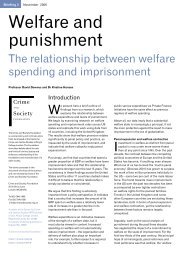PRISON SERVICE
PRISON SERVICE
PRISON SERVICE
- No tags were found...
You also want an ePaper? Increase the reach of your titles
YUMPU automatically turns print PDFs into web optimized ePapers that Google loves.
Perrie Lectures 2010The ‘Rehabilitation Revolution’Trevor Williams is Director of Offender Management for the Eastern Region.IntroductionBy way of introduction, let me first tell yousomething about the origins of the Perrie lectures.As a junior governor grade working in Long Lartinin the mid-eighties I had the great pleasure ofworking for a truly inspirational governor, MikeJenkins. Mike was old school, he knew how to runa very effective prison but he also knew theimportance of understanding the context in whichhe was trying to deliver that service. So we keen,eager apprentices, were encouraged to attenderudite seminars on matters of criminology.Returning from one such lecture on theimprovement of the lifer management system inOxford, I said to Mike, ‘surely there ought to be aplatform for those who work on the front line tohave a voice, to express ideas and issues aboutdoing the job on the shop floor?’ Mike thoughtabout this for a while and eventually said, ‘I thinkthat’s a good idea, Trevor, you should organizeone!’, and that was the origins of the PerrieLectures. Clearly the format has greatly improvedsince we created the first of those lectures and Iam truly delighted to see that its longevitysuggests that we found a basic niche in themarket, a cause that has remained constant sincethose days, with one of its core principles beingthe opportunity for different perspectives on thesame issues.Old school rehabilitationBut I digress. I joined the Prison Service in the lateSeventies and the recruitment pamphlet whichattracted me said that the purpose of imprisonmentwas two fold. The first was to keep people secure inconditions of ‘humane containment’ for the benefit ofpublic protection, with the second being that ofrehabilitation. It seems remarkable to me that so littlehas changed in the intervening 30 odd years. It isentirely true that although the label of throughcare hasdeclined in usage, the concept survives and in fact I amabsolutely confident that the notion of rehabilitation isabout to see a revival. An example of rehabilitationfrom the old days comes from my first job as a governorgrade in Feltham borstal. It was not the Feltham thatwe know today but the old Middlesex industrial schoolof the late 1830s which, until the Prison Serviceacquired it, used to have a fully rigged schooner in frontof the building which they used to train the waifs andstrays of London in seamanship skills before sendingthem to join the merchant navy. The Feltham that Ijoined was imbued throughout with the notion ofrehabilitation, as was the borstal regime. It was anindeterminate sentence; the harder you worked thequicker you got out but if you messed about youstayed.I remember spending my weekends writing ‘Page17’ reports, a simple report on each of our offendersstating what we’d learnt about them, what we’d donewith them and what work we thought remained to bedone when we discharged them into the hands of theProbation Service. We duly sent these things off and inreturn we used to get back a ‘Part C’ which was aregular, quarterly report from the Probation Officersaying how well or badly that individual was doing. Tome that seemed to be basic common sense, that isthroughcare in action. The fact that we managed itwith a couple of simple reports seems all the moreremarkable today. Feltham was also fairly unique inother respects regarding the rehabilitation agenda. Forexample, we ran a ‘drop in centre’ just off TrafalgarSquare where any ex-offender from Feltham, howeverex they were, could drop in, let us know how they weregetting on, ask for help with difficulties, and generallyshare their experiences with any recently releasedtrainees. I didn’t think that was innovative, I justthought that was plain common sense, but clearlythose kinds of services no longer exist, as far as I’maware, which says something about the way we havereorientated our thinking about our core services andour core purpose.Going further back in time, Feltham was thestarting point for the Lowdham Grange march. Felthamborstal used to put trainees through constructiontraining and in the early 1930s someone came up withthe idea of marching these men from Feltham toNottinghamshire where they could build a ‘modelborstal’. They trained up a workforce with constructionskills, marched them to Lowdham Grange, and built amodel borstal on the hill at Lowdham. Practitionerswere absolutely convinced that a regime ofrehabilitation, as lived and breathed by the trainees andthe staff was the way to do business. They were soconvinced by the premise that a couple of years later28 Prison Service JournalIssue 192











